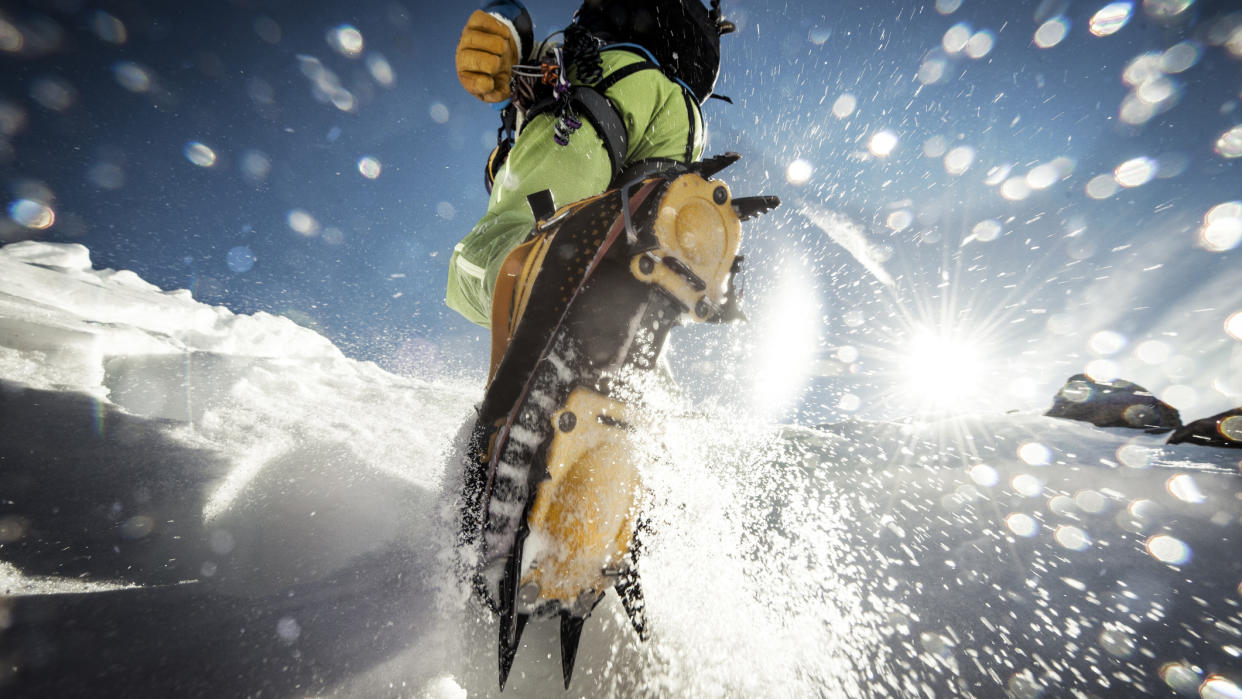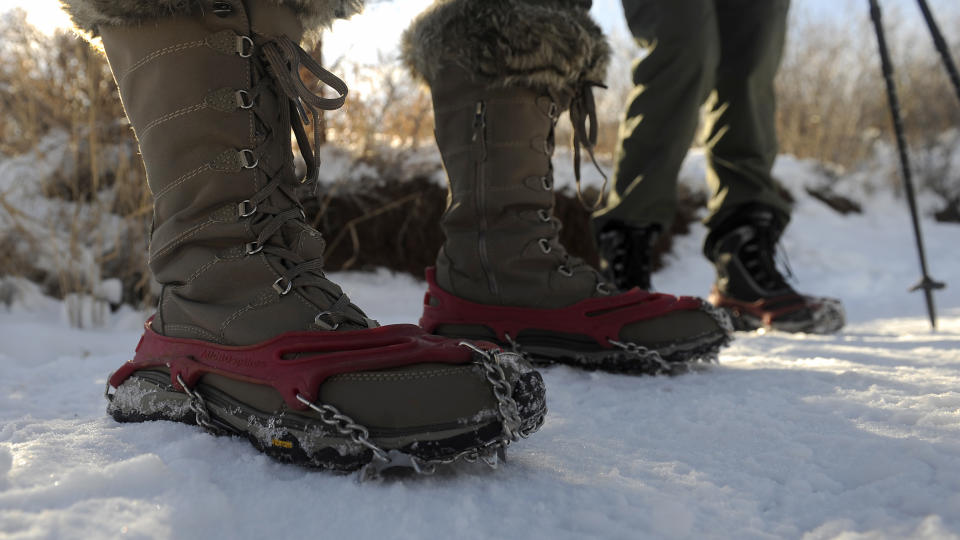Get a grip: our guide to winter traction devices for shoes

Traction devices for shoes continue to develop and evolve, allowing winter adventurers to access icy wonderlands in an increasing range of styles. For those who want to float across the surface there are options like snowshoes. But for those who want to bite into snow and ice, to move along gradual terrain at speed or take their adventures into mountaineering territory, this is where traction devices come into play.
Whether it’s just for a few weeks during the January cold snap or you’re expecting a six month-long snow season and have invested in a quality down jacket to see you through, traction devices for shoes offer great protection against falls and can keep you moving until spring arrives.
There are three main types of traction devices for shoes which each have different purposes. Some are better for packed snow, others for ice and each type is better for certain activities over others. A quick glance at the three main types of traction devices for shoes will help you easily figure out which you need to keep training and enjoying the outdoors through the cold season.
Meet the expert
Today's best deals
1. Coiled traction devices
Coiled traction devices feature elastic plastic uppers with steel coils on the bottom
They can be wrapped around hiking and running footwear
They are well suited to walking and running on packed or slushy snow
They are not suited to hard ice or steep ground

Coiled traction devices are simple grips made from elastic rubber uppers with steel coils on the bottom that you pull on over your hiking boots or trail running shoes and fasten with a velcro strap. The coils provide the traction when you’re walking or running on packed snow and ice.
The most popular brand of coiled devices is Yaktrax, named after the Tibetan yak, and they advertise that you can wear them in temperatures as low as -40C/-41F. Coiled traction devices are pretty affordable and work with any running or hiking shoe you might be using. They work best on packed snow and slushy roads as well as variable conditions where you might be moving through areas of tarmac. You can wear coiled devices for both hiking and running, and there are now activity-focused models available such as the Yaktrax Run Winter Traction Device.
Coiled devices aren’t so great for really slick, icy conditions, where they just tend to slide across the top, nor do they work well on steep slopes. Another downside is that they do tend to break rather easily. But for winter road running and gentle hiking on packed snow and slush, you’ll be happy with a pair of these and they won’t affect your gait too much.
2. Spiked traction devices
Spiked traction devices feature stainless steel chains and small metal spikes
They wrap around a shoe via a thermoplastic upper
They can be used on both hiking and trail running footwear
Spikes aren't great for road running of steeper mountaineering terrain

Spiked traction devices, often referred to as microspikes, look quite a bit like their coiled counterparts, with a thermoplastic rubber upper that pulls on over your shoes. However, on the bottom they feature stainless steel chains and spikes to bite more aggressively into the ice. Like coiled devices, spikes will work over both your hiking boots and running shoes.
Spiked traction devices tend to be a bit pricier than coiled devices, but they’re also more durable. These devices work great for hiking and running on ice as well as packed snow, however most of them aren’t useful for running on tarmac, so if you’re road running, you’ll be happier with coiled devices that you don’t have to keep taking off. Spiked traction devices such as Kahtoola’s Microspikes are great for icy winter trail running and hiking on gentle slopes, though it should be said that running in spikes can take a little getting used to, and it does tend to slow you down a bit. However, if you love running it’s probably better than not running at all.
There are definitely areas where you can use coils and spikes fairly interchangeably, such as popular trails in Colorado where the snow tends to be dry and well-packed down, but as you can see there are slight differences in their uses and neither might be much help somewhere with very mixed winter conditions, like Scotland. Learn more in our article on Yaktrax vs Microspikes. They're not suited to steeper mountaineering terrain.
3. Crampons
Crampons are metal frames armed with robust spikes that strap on to winter hiking boots
They're only compatible with certain kinds of boots and are not suited to running shoes
Crampons give excellent grip on steep, icy terrain

Finally, you’ve got crampons, which are a serious step up from either coiled or spiked devices. Crampons are a bit like spikes on steroids, with a rugged metal frame that fits over your winter hiking boots and robust metal spikes. Unlike either of the other two devices, crampons won’t work with running shoes and are not meant for running. Many runners will describe running with crampons, but they actually mean spikes.
The best crampons are designed for specific purposes, such as alpinism, mountaineering and ice climbing. They give much stronger grip on steep, icy terrain than spiked or coiled traction devices. There are different types of crampons that match different kinds of boots, gradients and terrain. See the table below for an at-a-glance overview of crampon grades.
Any sort of crampon will set you back about as much as a pair of hiking boots, so if you’re not planning on doing any of those activities, you don't need to own a pair of crampons. Further, if you’re undertaking a one-off winter expedition, you may be able to rent a pair.
Best trail running shoes: footwear for speed on tough terrain
